Fire Emblem Awakening: Official Developer Interview [Archive]
This interview first appeared on the official Nintendo website's Fire Emblem portal as promotional material for the original release of Fire Emblem: Awakening. The Fire Emblem website has since been redesigned for subsequent games, and this page removed - but we have republished it on RPG Site for archival purposes.

Huzzah and well met, milords and miladies! 'Tis we, the wordsmiths at 8-4, Ltd., come to deliver unto thee a prize so grand it will ring out in song for-- Wait, wait. *Ahem* Okay, sorry, that was Owain talking, I think... It's just, when you've spent the better part of the last twelve months working with Nintendo of America to translate and edit and polish pages and pages of text for the English version of Fire Emblem Awakening, it's easy to slip back into character...
We had the chance to interview the game's developers from Intelligent Systems and Nintendo, including a rare glimpse inside the Intelligent Systems office in Kyoto, Japan. As huge fans of the series ourselves we had burning questions about how exactly this latest entry into the Fire Emblem series was made.
We got answers plus an exclusive look at early concept art and never-before-seen details on the game's creation. So read on, and enjoy...OR BY BLOOD AND THUNDER WE SHALL FEAST UPON YOUR SOUL! (Oops! Noire that time, sorry!)
--@markmacd, @johntv, and @hiroko84 of 8-4, Ltd.
8-4: Why don't we start by having everyone introduce themselves, including your history with the Fire Emblem series.
Higuchi: My name is Masahiro Higuchi, and I was the project manager for Awakening, in charge of handling the overall progress of the project. The first Fire Emblem title I worked on was Seisen no Keifu for the Super Nintendo, and I've been involved with all of the Fire Emblem games in one way or another since.
8-4: Wow... Have you worked on any other games over the years, or just Fire Emblem?
Higuchi: Well, I've been involved with the [Advance] Wars games at times as well, since our team focuses on strategy games, but as a part of Intelligent Systems, we've also been involved with Fire Emblem the whole time.
8-4: Ah, Advance Wars! We'll have some questions about that later you probably can't answer... (laughs)
Higuchi: (Laughs) Yes, certainly.
Yokota: I'm Genki Yokota, the director on the Nintendo side. I helped keep things organized alongside Maeda-san, and we worked together to help conceive and drive the overall direction of the project. This was my first time being directly involved with the Fire Emblem series. I've played the previous games as part of the company's internal playtesting efforts, but I was never an actual team member until now.
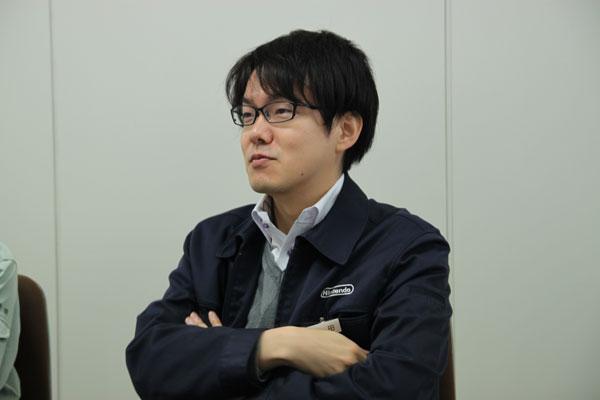
8-4: And what other games have you worked on?
Yokota: Before Awakening, I was a director on Xenoblade Chronicles. The original planning for Awakening started around 2010, right when the Japanese version of Xenoblade was wrapping up, so the timing worked out great. Overall I've worked on role-playing games. The first one was...what was it? (laughs) Well, it only came out in Japan, but it was a game called ASH: Archaic Sealed Heat, which we worked on with Hironobu Sakaguchi. Then after that came The Last Story, which was also with Sakaguchi-san. I also worked as a director on Fossil Fighters.
8-4: Indeed -- so how did you become the RPG guy? Was it personal interest, or more to fill a role that the company needed?
Yokota: Basically, when I first joined Nintendo, my boss asked me what I wanted to do, and I said "work on RPGs." I like how RPGs put a strong emphasis on characters and character development, like how you build your guys up from scratch.
So the first RPG I really worked on was Fossil Fighters, but it was Xenoblade that was the big catalyst to me taking on this role. I was asked if I wanted to work on it, and of course I said yes -- it was such a good fit that I started to get involved in other RPGs in a bunch of different areas. Also Nintendo typically doesn't make that many (RPGs), so whenever there's a chance to work on one I always want to take it.
8-4:Gotcha. Alright, Mr. Maeda?
Maeda: I'm Kouhei Maeda, and I served as the director at Intelligent Systems on this project. I first worked on Fire Emblem as a scenario writer for Fuuin no Tsurugi, and I've been involved with the series ever since. I've also worked on Advance Wars games as a designer, scenario writer, and director for the story mode.
Kusakihara: And I'm Toshiyuki Kusakihara and I was the art director for Intelligent Systems on Awakening. I joined IS in 2008. I've been in the gaming industry since 1998.
8-4: So it sounds like you all had some kind of working history with Fire Emblem before Awakening -- but I'm curious to hear everyone's first memories of the series as gamers? Did you play the games growing up?
Higuchi: To be honest, it wasn't until after I joined the company that I first played a Fire Emblem game. I had heard the name before, but never actually played one. When I first got into it, I had all these people around me saying things like "Don't move those guys there!" or "Move him over here!" and "No, you messed it up again!" They were all pushing advice on me. (laughs) It made me realize that everyone plays the game in their own unique way, and there's never only one path to victory. There are very few games like that, where everyone can take their own approach and still succeed -- that's what got me addicted to the series. Of course now I've become one of those guys pushing my approach on others, like "No, no, you have to move that guy over there!" (laughs)
8-4: What is your approach, by the way?
Higuchi: Well, I don't focus on magic; I prefer to rely on strength and just plow forward. So I don't bother too much with healers -- instead I use a lot of knights and mercenaries. I like to muscle my way through. (laughs)
Yokota: My first exposure to the series was in elementary school -- I saw Monsho no Nazo in a video game store, I think. I went through the whole unit introduction and was like "Wow, what's this?!" and bought it on the spot. At the same time, there was a Fire Emblem comic that I was reading; I remember being really drawn in by the artwork... I guess it was the way the game and comics really fleshed out the world that impressed me. That was probably my first encounter with strategy games, too.
- Fire Emblem: Monsho no Nazo: The third game in the Fire Emblem series. It was released in Japan only for the Super NES system in January 1994.
Maeda: The first Fire Emblem came out around my first year of middle school. It was super tough... I remember having to press the reset button over and over again. (laughs) I kept losing my party members, so by the time I finished the game, I only had this tiny little team left.
Kusakihara: I was in middle school, too, I think. I was at my friend's house and I was begging him to let me play something on his NES, so he broke out Fire Emblem. I liked RPGs, so for me, the battle scenes in Fire Emblem were really impressive, like nothing I'd seen before. So I borrowed the game from him and I got totally addicted, but it got really hard about two-thirds of the way in, and I finally gave up.
Then the second game, Fire Emblem Gaiden, came out, and I borrowed that, too. The thing was, my parents still wouldn't let me have my own NES (laughs), so I borrowed the hardware, too, and smuggled this little black-and-white TV into my room and played Gaiden on that. Man, that was tough! Especially with the black-and-white TV -- keeping track of which units were mine and which were the enemy's was a challenge. (laughs)
- Fire Emblem Gaiden: The second game in the Fire Emblem series. It was released in Japan only for the NES system in March 1992.
8-4: Did your parents ever catch you playing?
Kusakihara: Luckily, no. (laughs)
Maeda: Seriously? (laughs)
Higuchi: I figured the story would end with you getting caught and your parents throwing away your friend's NES. (laughs)
8-4:One aspect that made those old Fire Emblem games so tough was "permadeath" -- when a character died, he or she was dead for good (as in Classic mode in Fire Emblem Awakening). Judging by the Iwata Asks Fire Emblem chat, it sounds like there was a lot of debate about whether or not the new Casual mode (that allows dead characters to come back to life after a chapter is complete) was a good idea?
- Casual Mode: In this mode, when a friendly unit becomes incapacitated, he or she becomes available to use again after the current map is completed.
Kusakihara: Ooh, that's a tricky subject. (laughs)Higuchi:Tricky indeed. (laughs) I was on the side that said we shouldn't include Casual mode to the end.
Yokota: Even after Awakening?
Higuchi: Well...I still think about it. It's that nuance... If someone dies, you can't just go and resurrect them like in other games. You need to think more carefully about the value of the lives you're controlling in the game. It connects with the difficulty level, too -- it makes you work your way through the game very carefully, which I think makes each victory all the more exhilarating. It's one of the charms of Fire Emblem, which is probably why adding Casual mode generated a fair amount of controversy [within the team]...
Yokota: Oh, yeah. (laughs)Higuchi:But while permadeath is a part of the series, it's also something that I think kept a lot of people from trying the game. That's not good for us, if people don't even pick it up to see what kind of other things we've put into the game. And in the end we did get a lot of feedback from people who tried [Awakening] because of Casual mode, so in that respect I'm glad it's there. But I still play in Classic mode myself.
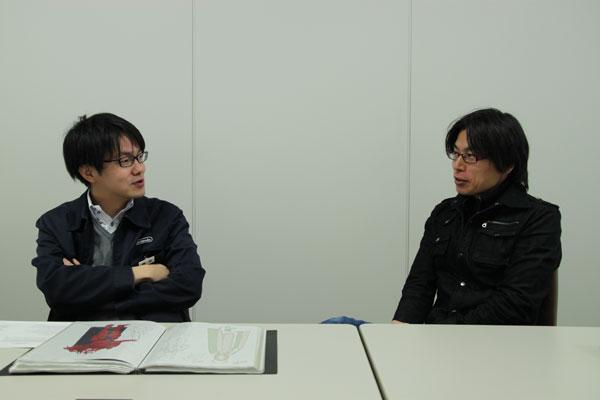
8-4: We've been hearing that feedback in the West as well -- a lot of first-time players are saying they'll give the game a try now with Casual mode because it's less intimidating.
Yokota: Personally, the first time I heard about [the idea of Casual mode], I was like "no way." My boss brought up the idea, and just like Higuchi-san, I was angry at the thought of going too casual. But in the end, we figured giving players a choice would help expand the appeal of the game. Plus, with Awakening, there are a lot of good characters -- you can see how some people would want a mode where they could keep all of them alive and not have to worry about death all the time. Believe it or not, now I play exclusively in Casual mode. (laughs) But like Higuchi-san said, some of the fun of Fire Emblem does lie in the possibility that you can lose a member permanently at any time. Both approaches have their advantages, so it's hard to say what direction we'll take next time.
8-4: Really? In a future game you'd consider not including the Casual mode option?
Yokota: I suppose it depends on the sort of play style we decide to go with in the next game... Well, I'm pretty sure we'll have Casual mode in there, actually. (laughs) In the end, you have people who really love the characters, and they don't want to lose them permanently when they save their progress. So that's why we added it, and I don't mind it being there. But on the other hand -- and this is just a hypothetical example -- let's say we wanted to depict a really big and serious war scene. In a situation like that, having permadeath would help lend weight to everything; it'd be much more tense and meaningful to players if their characters' lives were truly on the line, just like in a real war. So it really depends.
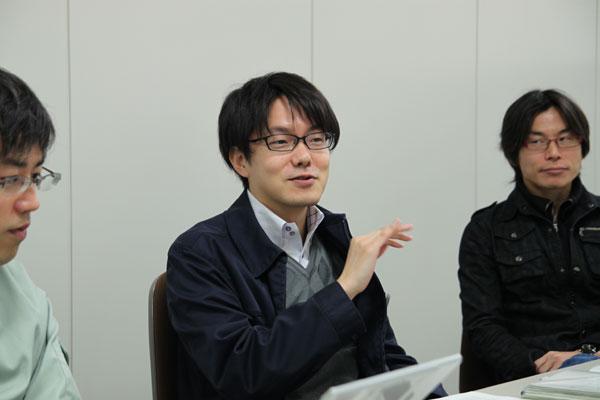
Maeda: I use both [Casual and Classic] modes when I play. I think there's value in each -- having a more pick-up-and-play mode in addition to the normal one. It brings two different tastes to the game... I don't think it's so much a question of one play style being better than the other -- they both have their good points. Fire Emblem's always had this core tenet of permadeath, so doing away with that was never really something we considered in the past. But whenever we'd have new hires entering the company playing the game for their first time, they'd lose a bunch of units and get completely stuck -- and thinking back, the same thing used to happen to me back when I started. So yeah, I think Casual mode was a good idea.
8-4:So you were all for Casual mode from the start?
Maeda: Well, the first time I heard about it... Hmm... (laughs) It definitely threw me. I didn't know whether I should be for or against it -- if it was the right thing to do for gamers or not...I thought I would figure it out.
Yokota: Me and Higuchi-san had been making a big stink about it, like, "No, no -- don't do it!" And then Maeda-san comes in and is all casual about it, like "Oh, let's just try it. What's the big deal?" (laughs) He was the one calm guy.
Kusakihara: Casual mode was first introduced in the Japan-only game Shin Monsho no Nazo, right? At the time, my desk was right next to Higuchi-san, and he was arguing every day with people at Nintendo about it. (laughs) That went on for months... Finally, one day he asks me [out of the blue] "What do you think about removing permadeath?" My response? "That's not Fire Emblem!" (laughs)
- Fire Emblem: Shin Monsho no Nazo: Hikari to Kage no Eiyuu: The thirteenth game in the Fire Emblem series. It was released in Japan only for the Nintendo DS system in July 2010.
Higuchi: Yeah, there was a lot of complaining. But then Maeda-san would come in and smooth it all over. (laughs)
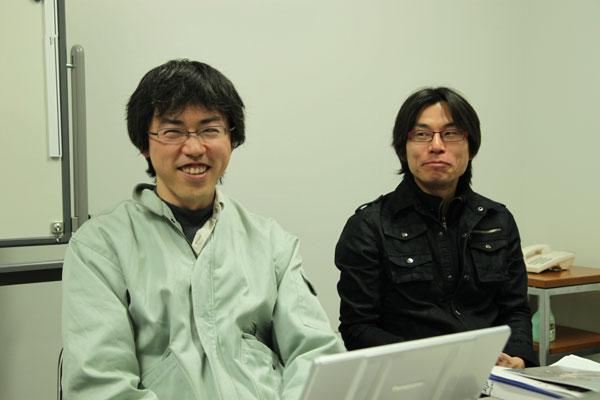
Kusakihara: The funny thing is, when I play now, I play in Casual mode!
At its core, Fire Emblem can be a pretty difficult game: Your units all have these well-defined weaknesses -- for example, if you're not being super careful, one wrong move with a Pegasus unit and they're killed by an arrow. Players who've been with the series a long time are used to permadeath and watch out for those sorts of things, but for novices, or even people like me who come back to the series and are still adjusting to all the new rules and features, these kinds of easy mistakes can easily cost you a character or two...
So I think it's good that we offer the choice between Casual and Classic... In online forums and such, you'll see veteran players and people who probably had their first Fire Emblem experience with Awakening still debating which is better.
8-4: Speaking of veteran players, we know a lot of hardcore fans who go so far as to replay a battle if they lose even one unit...
Yokota: That's how I played before Awakening. (laughs)
Higuchi: That's how I play, yeah.Maeda:In Classic Mode, definitely, I reset if lose someone.
Yokota: I even reset if I don't like how my [randomly generated] level-up stat gains go. (laughs)
8-4:So, be honest -- don't you secretly look down on people who play in Casual mode? (laughs) Maybe feel a little ashamed of yourself when you play that way?
Higuchi: (Everyone laughs) I don't, actually. I play the way I enjoy the most, and if a lot of other people play it differently, then that just tells me there's a big, wide audience playing it out there. Personally, when I watch other players, it's less looking down on them because of Casual mode and more like, "Whoa, what -- you're putting that character over there?!" (laughs)
8-4: C'mon, Higuchi-san -- don't you pity them even a little? I said "be honest." (laughs)
Higuchi: No, no, I don't! I'm very Zen about it. (laughs) Although I admit, I did start playing Lunatic in Casual mode, but partway through, I started to feel like I was betraying my beliefs, so I started over in Classic mode. (laughs)
Yokota: I wouldn't say I look down on Casual mode players... (sarcastically) I know you do, Maeda!
Maeda: No, not at all! (laughs) As a guy who plays in both modes, I have the opposite attitude -- I'm impressed when people play Classic. It's like, "Wow, you're really into the game!" I've actually played through the game in Classic mode, too -- on Lunatic+ difficulty, even -- but I'd never chide anyone for going Casual...
Yokota: Basically, one of our goals was to get people who never played Fire Emblem to give it a try, and we succeeded at that, so honestly, either play style really is fine.
8-4:I think previously if you asked what sets the Fire Emblem series apart from other games, a lot of fans would have said permadeath. But the popularity of Awakening and Casual mode seems to say there's more to it than that...
Maeda: I think a big part of the appeal is the love you develop for the characters. You're basically playing a strategy game with pawns here, but the game is set up so that players see their units as more than just pawns -- they see them as living things. They get attached to them.
Yokota: That's what I was going to say. (laughs)
Kusakihara: I think a big key to that is how the games portray the lives and emotions of all the characters -- even the standard enemy units. We've gotten feedback that we should give all the units names, even the unimportant [grunt soldiers]. I think that's all part of the unique feeling Fire Emblem creates -- we work to make it seem like each unit has their own life, so when somebody dies, their presence stays with you in a way. That's why all the enemies in this game have full artwork as well as the main characters -- you can see their faces on-screen when comparing battle stats and such.
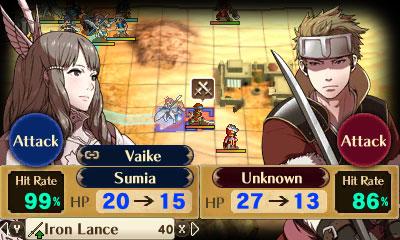
8-4:What other methods do you use to achieve that -- making players care about their troops?
Yokota: Well, we work really hard to make all the characters unique -- not just how they look, but their stats, too. For example, there might be a character whose Speed parameter starts off high or levels up really quickly, and you start to use them in all these different ways in battle... You can develop this feeling toward them, like they're the backbone of your army [and a key part of the game], even if they aren't very involved in the main story... The unique parameters definitely help players bond with their team.
And there's also the ending in each game that goes over what happened to everyone involved... There are lines like "This character disappeared, and nobody knows what happened to them..." That kind of stuff encourages players to imagine what might have happened. Obviously we give players a sense of the characters through all the conversations that happen in the game, but at the same time we also try to leave some freedom for people to create their own stories...
8-4: So let's talk about how you actually go about creating a Fire Emblem game. What are the first steps, what all is involved, how long does it take, etc.
Higuchi: Well, with Awakening, it took quite a bit of time between the first design documents and the completed product. Things got more organized later once people like Yokota-san joined the project, but I think it was about a year and a half between the initial proposal and the point where we got approval to move forward.
With this Fire Emblem, one of the goals was to try and tackle new challenges, though of course we try to do that with every game in the series... Anyway, we'd submit new design ideas, and Nintendo would spend some time reworking them [and send them back], and we went back-and-forth like that for awhile.
Yokota: The project really started to move forward once we settled on the concept of making a definitive kind-of "all-star" Fire Emblem that takes in everything [from previous games] that made the series great. I'm not sure who first brought up that idea -- I think it came from when Maeda-san did an internal survey within the company?
8-4:Speaking of the early design ideas, in that Iwata Asks on Awakening, you mention some pretty crazy concepts you had. Like setting the game on planet Mars? Or in a modern-day setting?
Higuchi: Well, there were definitely a lot of proposals. (laughs)Yokota:I think [that Mars idea] was near the end of the proposal process.8-4:So after the project is pitched and a direction is finally approved, what happens next?
Maeda: Once we get the official "go" from Nintendo, we form an internal team [at Intelligent Systems] for the main development work. This team has all the basic building blocks we'll need: designers and programmers, artists and sound guys -- and they all start working together to create the game.
Basically, the director and designers come up with the overall structure, and that gets turned over to the programmers and artists so it can be coded and drawn and such. We work as a team, of course, so over the course of development a programmer or artist might also have suggestions to make the gameplay more fun or engaging... It's all those suggestions along the way that add up to the final game.
Higuchi: This was also going to be the first Fire Emblem game for the [at the time] upcoming 3DS hardware, and so me, Maeda-san and Kusakihara-san all had a ton of ideas on what we wanted to do with the platform. We started experimenting with just a single map in order to see how practical all our different ideas were... We'd work with Nintendo to implement each feature and see if it worked and could get approval, then move on to the next, one after the other. That was the basic workflow.
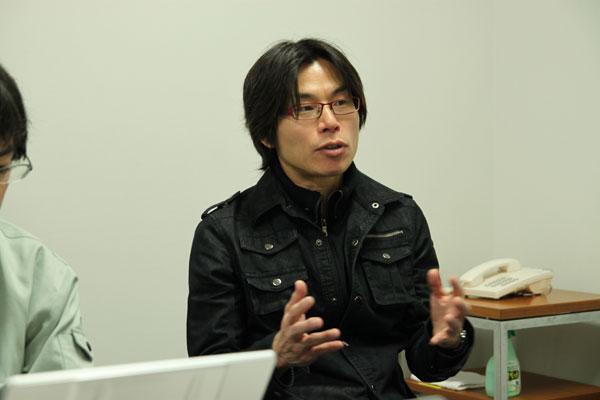
8-4:Did that test map end up in Awakening in any form?
Yokota: [Yes,] the map we used was actually the first stage from Fire Emblem: Monsho no Nazo. We needed something to experiment with things like different terrain types and geography before the designers started working on the new maps [for Awakening]. It wasn't used in the main story of Fire Emblem Awakening but it was used in the side story.
8-4:What other sorts of features were you experimenting with early on?
Yokota: Well, this was our first time with a lot of things, not least of which was working on a platform with true 3D graphics. And since we started development before the 3DS hardware was finalized, we had only a vague idea of what it would be capable of. So we tried things like building the map and unit icons all in 3D polygons -- seeing how the [system] memory might handle things, trying to determine the benefits of making the units 2D or 3D, that sort of thing. Also, different ways of transitioning in and out of battle scenes -- things like that...
The hardest part was figuring how to make the 2D unit icons look good on a 3D landscape, and not clip through objects. In a 3D space, you can't really cut corners when drawing graphics, or else it just winds up looking strange. For example, if you draw a 2D character near a building, if you aren't careful, part of the building can overlap the character. You can adjust the drawing priority to move the character "layer" up, but then the character can start to look further away from the building than it actually is. Dealing with that was a new challenge for us -- it was really difficult, especially at first...
8-4:Is this (document here) related to these early graphical tests? The one with two versions of the same map labeled "16 character" and "24 character"?
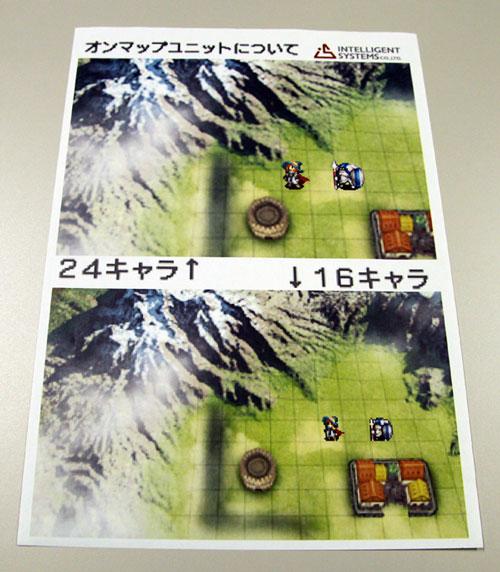
Kusakihara: Yes, actually, these were part of our first experiments. This one was to try different sets of graphics and have the game switch between them depending on if the camera was zoomed in or out. The "16 character" version used a 16 x 16 pixel box for each unit, and so on. In the course of development, though, we decided to use hardware-based scaling instead [of switching between different sets of graphics].
Higuchi: We did that to help the game run faster. We always make an effort with the Fire Emblem games to keep things running as quick and efficiently as possible... Our goal with Awakening was to keep the map sections running at 60 frames per second and the battles at 30, and never even come close to dropping a frame in the middle of gameplay. I think all that effort really paid off -- Awakening feels great.
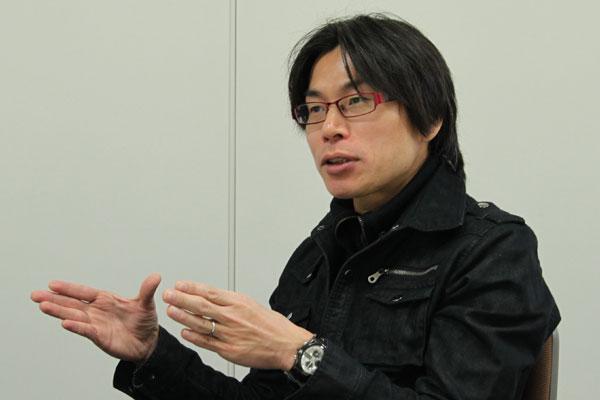
8-4:OK, so once you have the basic technical stuff worked out, what comes next? Does the story define what kind of maps should be made, or do you decide the maps first and then build a story around them?
Maeda: First we come up with the general outline of the story. Once that's done, we go through every chapter [from the first to the last], and decide what kind of map it will be and what kind of enemies you'll fight there. All the maps go through that process at the same time.
8-4:Who exactly comes up with that story outline? And is that set in stone, or is there room for it to evolve as the game comes together?
Yokota: Mr. Maeda thought of the main story this time and wrote the outline for the main story.
Maeda: And things changed along the way, yes. (laughs) One thing common to all Fire Emblem games is that gameplay gets first priority -- if something will improve gameplay, we don't hesitate to rearrange other elements like who enters your party when, how each map is arranged, and that sort of thing. This stage of development is basically one long, extensive trial-and-error process.
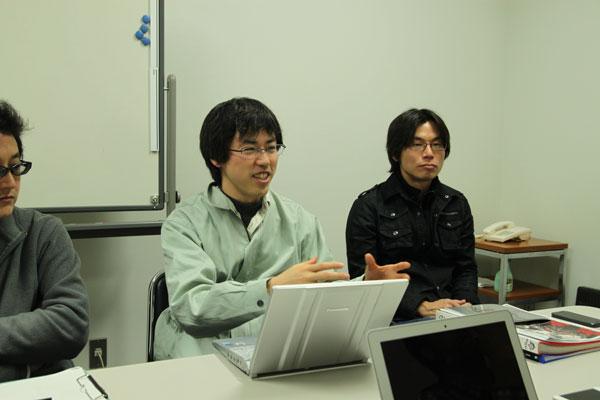
8-4:So who is performing these trials and who is judging the errors?
Maeda: I played a lot myself -- through the entire game probably a number of times or so... And of course we have playtesters as well. A few people within the team and sometimes a few outsiders -- we had them try out the game on several times (throughout development) and give us their feedback, then we adjusted the game based on that.
8-4: You recall any particularly strong feedback you got along the way?
Yokota: Oh yes. (laughs) There's this one guy in the sales team at IS who was probably our harshest critic. I remember he complained that you were only allowed to marry one person in the game -- that there was no way to divorce or anything. (laughs) Another guy wanted the ability to be married to multiple people at the same time. (everyone laughs)
8-4: How about an example of a big change you ended up making in the course of development?
Yokota: This might overlap with what we discussed in the Iwata Asks, but one big change was how you [the Avatar] are able to marry almost any unit you want. When Maeda-san first suggested it, I was like "Are you nuts?!"Maeda:I guess that did end up being a pretty big change. (laughs)
8-4: Well since you brought it up, let's talk a bit about the marriage system. Why'd you decide to include it in Awakening?
Higuchi: Well, as we talked about before, one of the guiding principles of this project was to pack in as many great features from previous Fire Emblems as we could into one game. The goal behind this was partly to give current fans access to all this great stuff, but also to serve as an introduction to the series for new players. We wanted to provide this extensive package for them to explore, to serve as a statement, like "This is what the Fire Emblem series is all about."
Also, one thing we haven't really discussed yet is how Fire Emblems always involve a large number of characters interacting with each other -- talking, fighting, experiencing this epic fantasy story filled with love and courage... The bonds that tie characters together are an important aspect of the story, and we wanted to somehow make that deeper than ever before. That's what lead us to the marriage system, as well as the Pair Up system. It's all to encourage those relationships and strengthen that bond between the player and their troops.
- Marriage System: A feature first included in the Japan-only Fire Emblem: Seisen no Keifu for the Super NES system.
- Pair Up system: A feature in Fire Emblem Awakening by which two characters can occupy the same space in battle to provide stat boosts and get them working in tandem.
8-4: Let's get back to the creation process: how do you go about designing each different map?
Maeda: In the beginning, we start with a sheet of graph paper -- just draw mountains and rivers and so forth on it. Then we get that into digital form on a PC so it can be playtested. At this point, there's still really no visuals to the level; sometimes it's literally just the word "RIVER" and such onscreen. (laughs) That's how playtesting begins.
8-4:So what sorts of things are you looking for in playtesting level designs? What makes a good level and what makes a bad one?
Yokota: Well, there are a few patterns... Hmm, this is a tough question...Maeda:One thing that I notice, and I think this is the case with Advance Wars as well, is that a good map needs to have a directed purpose -- something that you want the player to actively experience. It's nice if a map looks really flashy, but ultimately it's more exciting for the player if, for example, there's a crisis point they have to fight through, or some other concept that defines the map. I think the more maps that have those kind of defined concepts, the better the final game.
8-4:So when you're making a map, you're thinking of the way you want the player to experience it? What about allowing freedom to account for different play styles?
Maeda: I think you need to provide for both cases. With this game, some of the maps were built around a directed purpose, while others were built to allow more freedom. Personally, I prefer maps that are structured kind of like puzzles, where you have to do certain things, cover this and that area, and it's "solved" once you do that. But if you have a lot of different people try a map like that, some of them may just never figure it out... So you have to try and strike a balance keeping all that in mind.
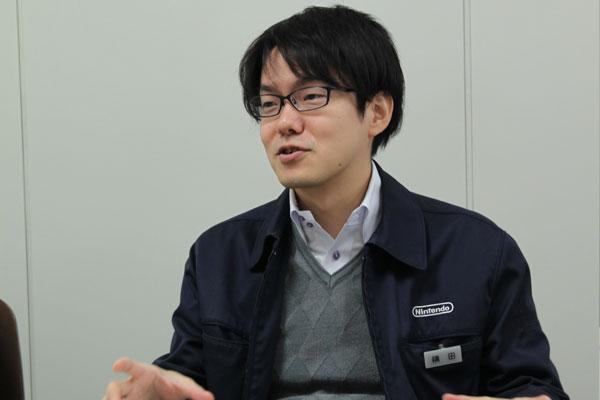
8-4: Speaking of balance, what about difficulty -- don't you lose perspective on judging what's too easy and what's too hard when you're playing the game over and over for months?
Maeda: The playtest sessions help keep you objective. We have a variety of people test out levels -- not just people familiar with Fire Emblem, but also people who've never played it before. That feedback is our guideline when it comes to difficulty.8-4:So what would you say is the hardest part of making a good Fire Emblem game?
Higuchi: Well, this is a game where you're controlling a large number of characters through a fairly epic-sized story, so you have to make sure the narrative is extensive enough that players care about what they're playing -- but at the same time, too much story can hamper the gameplay experience. Balancing that is the hardest thing, I'd say.
To figure out the right mix, we had people write up reports during their playtest sessions outlining the characters they used in each chapter, whether they leveled them up or not, their general impressions of the level -- that sort of thing. It was always interesting how different people would be so cold toward some characters and use others all the time. Anyway, those reports helped give us a good sense of which units people might want to see more of in the main story.
8-4: So I'm curious -- if you guys had to fill out that report on your own game, who are your favorite characters, both in terms of story and who you end up using most in battle?
Higuchi: My favorite character? Hmm... Well they aren't really part of the main cast, but among the male troops, I like Gregor, and for the women, I'd say Tharja.
With Tharja, I just really like her design, how she looks. And with Gregor, you have this middle-aged man who's proportioned pretty realistically for his age, and I guess that just resonates with me for some reason. (laughs) As for strategically useful characters -- like I mentioned, I tend to go all-out offense, so I use a lot of sword-wielding characters and manaketes.
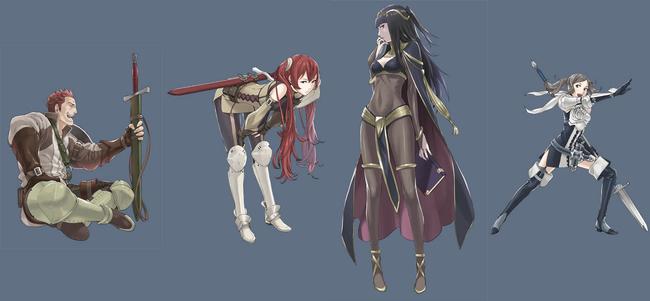
Maeda: Storywise, I have to go with the Avatar character [that the player creates]. You can change his or her appearance and voice and so forth as much as you like, which really increased my affinity for that unit especially. In battle, I like Tharja, because she's really strong. (laughs)
Kusakihara: I think Cynthia is my favorite story character. She had to go through a great deal of difficulty, but she still tries to be as bright and cheerful as possible no matter what, which I think is pretty cute. Battle-wise, I like characters with few weaknesses, so I use the two cavaliers a lot, Stahl and Sully. They move fast, and as long as you don't run into someone carrying a Beast Killer, they're a pretty reliable presence on the front lines. I have to agree with Maeda-san, though; Tharja is pretty strong. (laughs) She's pretty much the perfect fighter.
Yokota: In Japanese interviews I usually say Lucina for this question. I really like her, but I don't want to be pinned down to one person because Tharja isn't bad, either.
Higuchi: (laughs) We can't all say Tharja!
Yokota: Well, she's a popular character! She's strong and has a really interesting personality. Lucina was a character that survived from the very first concepts; she's a really fascinating woman, visually as well... Hmm, I like Severa, too -- I guess I mostly like women. (laughs) But she's very easy to understand, and as a sword user, pretty strong as well.
8-4: Let's talk a bit about the story -- without giving anything away, the story has some pretty big, surprising twists. Were those all planned that way from the start?
Kusakihara: It depends. For example, the true identity of Marth was something we had decided upon from the beginning, but a lot of the other twists came about naturally during development. We'd complete a section, and then it'd get passed around Nintendo and the rest of the office. As this or that part of it would be adjusted, we'd start to say "Let's add more to this element of it," and eventually it'd develop into these twists. I think most of them got their start on the Nintendo side.
8-4: What about all the characters? How do you determine what their personalities would be like?
Maeda:With all the major characters we have an overall story that we want to tell, and we basically assign characters roles which we feel they'll fit the best. Meanwhile, with the sub-characters who don't figure as much into the main story, we field material from all kinds of different places as we build them. And then having good guys be flawed, or bad guys have some redeeming factors... These are things you'd often see in Fire Emblems from way back.8-4:How do you go about writing all the dialogue and such for such a huge game?
Maeda: It's certainly a team of people that's involved with writing the story. For example, with the support conversations, those mostly got divided up in terms of different writers saying "I want to handle this character!" and we'd divide it up like that...
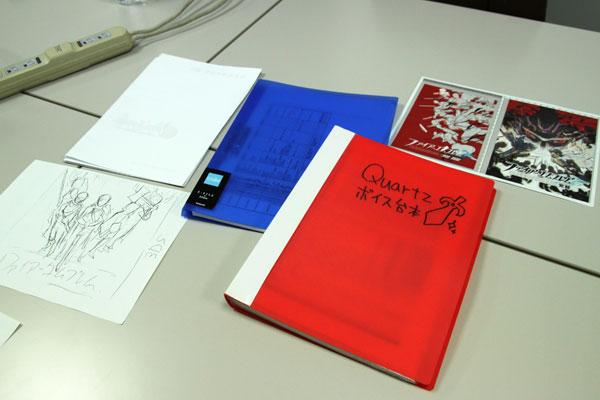
8-4:How do you keep everything straight? All the different ways characters talk and all their personality traits -- is there a big story bible someplace or something?
Maeda: There is a document that defines all of the basic character traits, and the dialogue was written based off of that. There's also one person on the team whose job it was to check over all of this text and make sure that there aren't any contradictions or inconsistencies anywhere. It was definitely a lot of text for one person to go over. (laughs)
8-4: On to the visuals -- Awakening has a different style from any of the previous Fire Emblem games. Can you talk a bit about the direction you decided to go, and how you chose that?
Kusakihara: There was definitely a movement with this project to give everything a fresh new look, so we wanted to find a character designer who could work in a different direction from previous FE games. The man we found was [Yusuke] Kozaki-san, who was involved with No More Heroes, which was a pretty well-received game overseas. That was actually part of the reason we hired him, since we were planning to release Awakening outside Japan from the start. Kozaki draws comics as well, and he's capable of coming up with a lot of different and varied characters on a common theme. So we asked him to come up with lively characters and a lot of different facial expressions...
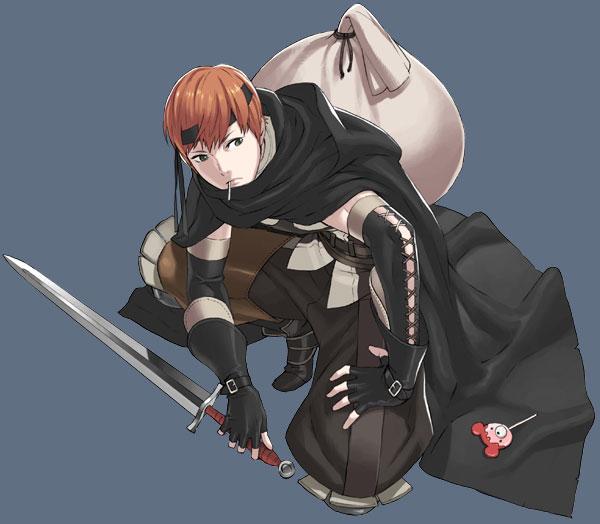
One of the rules that Kozaki-san always tries to follow is that his character's basic personalities bubble up to the surface, so you can look at a character and immediately tell a fair amount about what's going on inside their mind. For example in Awakening, Gaius is a character who likes sweets, so Kozaki-san drew him literally carrying candy. His final concept art has him with this teddy bear-shaped lollipop attached to his clothes; he submitted that to Higuchi-san and was like "Hey, I don't know about this, but what do you think?" (laughs) And Higuchi-san said "Sure, why not?" I think that both IS and Nintendo had the same outlook in terms of trying to make a fresh new visual feel for the game...
For example, this was Kozaki-san's original idea for the game package. Nintendo thought it wasn't all that different from what they had before (with previous Fire Emblem games); they wanted something more like a group portrait. So it went through this whole process before reaching its final form... It's just one more thing that demonstrates the drive this time to do something very different from before -- not just coming from us, but from Nintendo as well.
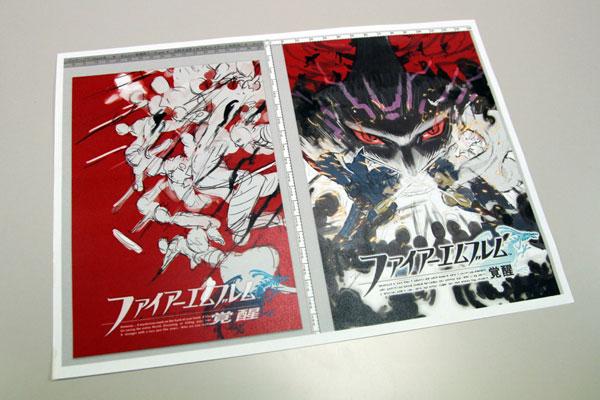
8-4:Speaking of doing something difererent, we have to ask a question a lot of the fans are wondering -- what happened with the feet? (laughs)
Kusakihara: (Laughs) Well, they're there...they're just...omitted a little bit.
The idea was to add a unique sort of deformation to the characters. As for why it ended up like this... At the start of the project, we weren't entirely sure how many bones and joints we'd be able to use in each character model. As it is now, there's a joint at the knees, and then there's nothing below that for the ankles and the feet. This makes it a bit easier to apply animation to models as well. We found out afterward that, with the 3DS, we had more than enough CPU strength available to flesh out the models a bit, add real ankles and so on. We were like "Well, if there's a next time, maybe there'll be more ankles..." (laughs)
We thought we could make it something that would work well with the characters, but now I'm not so sure. (laughs) So it's hard to give a real reason for it, but...well, I think it's kind of cute, though! (laughs) Isn't it? They look like they're wearing high heels. Aren't high heels the big fashion these days?
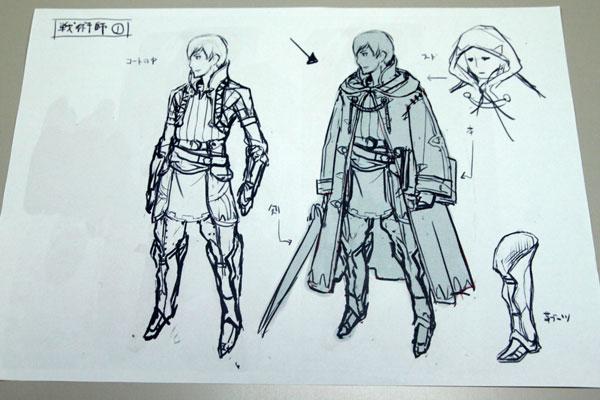
8-4: Did you get any feedback about this from Japanese players as well?
Kusakihara: Yeah, some people focused on the feet a lot. (laughs) I think if this was a game that involved people kicking and such, we would have put in real ankles. Instead, you're using handheld weapons for the most part, so we figured we could sort of omit some of the detail down there...
Yokota: We did get feedback about that in the playtesting sessions, but by that point it was like "Well, we can't do much about that now." (laughs)
Kusakihara: A lot of people seemed really preoccupied with the feet... Ah, well. (laughs)
8-4: You mentioned earlier it was part of the plan from the start to release this game overseas. Were there any other aspects of the game design besides the art where you took that into account?
Kusakihira: Sure -- another example is the first-person camera in the battle scenes. We didn't know whether it would be popular or not, but we made a calculated risk that people in the West would like to see the action take place from their own perspective. We also wanted something that really showed off the fact this was a 3D game...
But more important than targeting the West in particular, we wanted a set of visuals that anyone could easily comprehend and enjoy. For example, here's a smaller detail: The cursor in these sorts of games is usually a triangle of some sort, but for Awakening, it's a pointing hand. That's just one small part of the effort to make it easier to understand, visually.
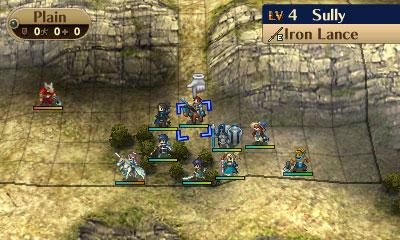
8-4: You talked a little about DLC in the Iwata Asks, but I was hoping you could elaborate a bit on your philosophy or thinking with the DLC - what you wanted to achieve with it, and what you wanted to avoid.
Yokota: Once we finished up the main game, myself, Maeda-san and the rest of the IS group began discussing what sort of things we'd like to see in the DLC, stuff that people would like to see after playing all the way up to that point. We talked about having extra stages with characters from older games, giving people really cool items, that sort of thing. That was the starting point...

8-4: A lot of the DLC introduces characters from past games. How did you go about choosing which legacy characters to include?
Yokota: We just used the characters Maeda-san liked. (laughs)
Higuchi: The idea was that we'd concentrate on main characters from the past games; then we debated over which ones felt right to include. Ultimately it was up to Maeda-san, though.
Maeda: We talked about which characters were the most popular, and which ones people would be most excited to control [as playable characters]. That was what I tried to base the decision on.
8-4: You've completed two full rounds of DLC so far in Japan -- is that everything? Any plans for more in the future?
Higuchi: No comment. (laughs) Well, if we have the chance we'd certainly like to do more, but as of now there are no plans for a third round.
Yokota: There aren't any plans, but if there's a demand for it... (laughs)
8-4: What about Advance Wars? A lot of fans in the West wanted to ask if we'll ever see Advance Wars again?
Yokota: (laughs) Hey, who should answer this?
Higuchi: Well, whether it's Fire Emblem or the Advance Wars, we never want to put an end to any series we're involved with. We always want to make games that provide a lot of fun to gamers, so if we have the chance, we'd certainly like to make another [Advance Wars] title.
8-4: Are the two teams -- the Fire Emblem team and the Advance Wars team -- mostly the same people, or is it just a few key members that overlap?
Higuchi: Well, depending on the timing of development, the people at the top might be different because they can only focus on one project at a time, but generally speaking, the main staff creating the games consists of the same people.
8-4: OK, just a few final questions -- first, favorite moment or battle in Awakening?
Higuchi: My favorite... Well, both of my favorite moments take place during cutscenes. One is when Marth makes his first appearance early on in the game, and the other is when the Fell Dragon Grima first appears later on. Both of those scenes are really major turning points in the story, and I hope everyone gets to see them both.
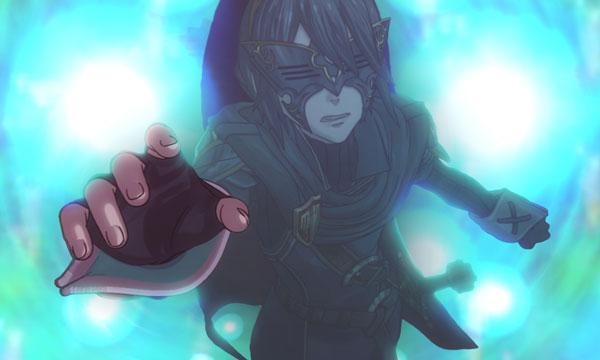
Maeda: As far as battles go, I really like the final stage. The first time you see it, it really throws you. It's like "Whoa, what is this?!" Even people around the office were saying that while we were developing it. (laughs)
Kusakihara: People were all saying "We want to fight THERE! Let us fight THERE!" and finally everyone said, "All right, let's do it!" -- but all I could think was: "Why doesn't he just roll over?" (laughs)
For myself, I think it's Chapter 10. In terms of story, music, and just how it looks, it's a really great stage -- the sort of thing that sticks in your mind for a while to come. It's not a particularly happy part of the story, but it's a part I like anyway. Also, I really love the scene in Chapter 21 where [X confronts Y -- edited for spoilers]. It made me cry a little bit.
Higuchi: Maeda-san made you cry... (everyone laughs)
Yokota: This is the first title to have voiced characters in the story sections, and I enjoyed a lot of the spoken lines there. I like the way Chrom and Marth's lines about changing or challenging fate really describe the whole game...
As for maps, I like Chapter 18, where parts of the level are gradually overtaken by lava. It puts you into a panic while you're playing it, but I think it's really fun.
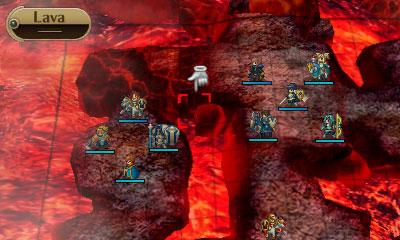
8-4: We asked before what the most difficult part of making the game was -- what was the best part? What is your favorite memory of developing Awakening?
Higuchi: Well, when a new title has been greenlit and you start work on it, all you can think about for a long time is how you have to get this done. But then finally one day, I remember we got the completed main musical theme in; when I heard it, I felt like "Wow, things are really starting to come together!" In a lot of respects, that moment I first heard the theme was really the happiest inspiration I had for the whole project.
Maeda: I think it was all the playtesting. (laughs) From the perspective of a developer like me, maybe I shouldn't say this, but there's always -- or hopefully there is -- that moment during the project where you're doing some playtesting and you have that sudden realization like, "Wow, this is actually pretty fun!" It's a great feeling.
Kusakihara: The thing with this project was that once we got started, we didn't have a lot of leeway as far as the schedule was concerned. We had to work on a lot of different things in tandem throughout development, handing out assignments to all these different places and trying to put them all together once they were done. Because of this approach, it felt like there wasn't much going on for a while, and then all of a sudden, things came together really, really fast toward the end. It really felt like we'd accomplished something, which made me incredibly happy because things often got pretty crazy up until then...
Yokota: Three different occasions come to mind. First, for someone like me who's been familiar with Fire Emblem for a while, hearing the news that we were going forward with the project was really a rush. Next was when I heard that we were going with Kozaki-san for the character designs; that was another "All right!" kind of moment. The third overlaps with what Maeda-san said: that time spent playtesting, trying to figure out which classes and parameters and maps were the best was a lot of fun.8-4:This one's super random, but, we noticed you often refer to Awakening as the 14th game in the series. But many fans consider it the 13th game. Which is it?
Yokota: Ah, that. (laughs) Well, there was a version of Fire Emblem released for Nintendo's Super NES Satellaview service in Japan in 1997. If you include that, then Awakening is the 14th Fire Emblem game.
- Satellaview: A satellite modem peripheral and network service that debuted in Japan for the Super NES in 1995. The service was discontinued in 2000. BS Fire Emblem: Akaneia Senki: A set of four short Fire Emblem games broadcast on the Satellaview service in Japan beginning in 1997.
8-4: OK, I think we're about out of time! Before we go, anything you'd like to say to your fans in the West?
Yokota: Awakening offers a lot of choices to the player in terms of classes, characters, and how you build your team and advance through the plot. I'm hoping that players enjoy carving out their own story in the world we've provided, and enjoy swapping tips and different play styles with their friends.
Kusakihara: One thing you'll find is that in giving your troops new classes, you'll often find a surprising character/class combination that actually winds up working really well. Try looking for things like that -- classes that make characters look really cool and stuff. (laughs)
Maeda: As we talked about, we tried to get everything we could into this game so both series veterans and people new to Fire Emblem can enjoy it, so I'm hoping that both audiences can enjoy Awakening. Oh, and Advance Wars fans, too. (laughs) A lot of Advance Wars team members worked on this game, after all, so I think AW fans might have fun with it, too. (laughs)
Higuchi: While the core of this game hasn't changed that much from previous Fire Emblems, it's a really new experience with the 3D graphics and voicework. That goes for the music, too; you can hear snippets from the main Emblem theme throughout the game -- it really helps add that unique atmosphere the series is known for in a wonderful way.
Also, we talked earlier about how this is a story about the bonds between people, but especially with the marriage and child-based story elements, we've put enough volume into the scenario that, no matter what kind of a player you are, you're guaranteed to find your own story. I'm hoping that people will play through the game not just once, but multiple times to see what kind of new stories they can unravel.
Yokota: Higuchi mentioned the music, but I want to stress that I think it really turned out great. We used up a lot of (memory on the cartridge) just for that, you can enjoy the music more by listening with earphones on. [laughs]
Also, you're able to create your own unique characters and children in Awakening, and I'm hoping that people take advantage of the StreetPass features to share their characters and create their own unique teams as well.
Higuchi: By the way, I mentioned earlier that Tharja was my favorite character, but since everyone else went with her too, is it all right if I change my answer? (everyone laughs)
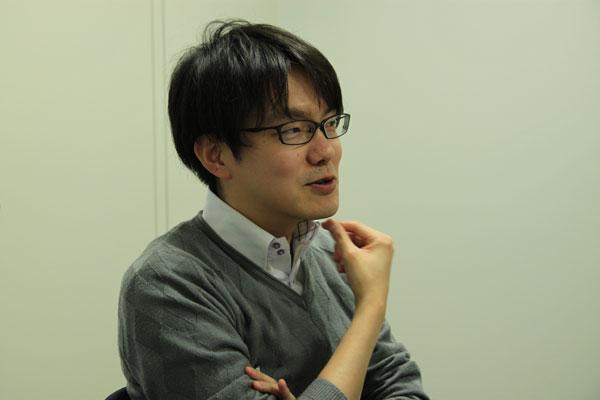
(after a pause) I'm gonna go with Cherche. She's the first character that Kozaki-san came up with -- I didn't use her much in battle, to be honest, but she seems like a good wife and mother. (everyone laughs)
8-4: Fair enough! Thanks for talking with us. We really appreciate it.